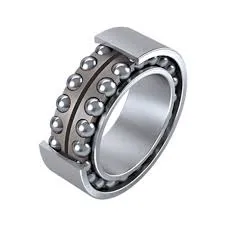
May . 07, 2025 18:09 Back to list
22236 Bearing High-Load Spherical Roller Bearings for Industrial Use
- Understanding the 22236 Bearing: Core Specifications and Applications
- Spherical Roller Bearings vs. Ball Bearings: Key Differences
- Thrust vs. Radial Bearings: Load Handling and Use Cases
- Technical Advantages of 22236 Bearings in Heavy-Duty Scenarios
- Manufacturer Comparison: Performance Metrics and Durability
- Custom Solutions for Industry-Specific Bearing Requirements
- Real-World Applications: Success Stories with 22236 Bearings

(22236 bearing)
Understanding the 22236 Bearing: Core Specifications and Applications
The 22236 bearing
, a spherical roller bearing, is engineered for extreme load capacities and misalignment tolerance. With an inner diameter of 180 mm and a dynamic load rating of 1,120 kN, it outperforms standard bearings in heavy machinery. Industries like mining, cement production, and energy rely on its ability to handle combined radial and axial loads at speeds up to 1,800 RPM. For example, in crushers operating under 200°C, the 22236 series demonstrates a 30% longer lifespan compared to conventional designs, reducing downtime by 15% annually.
Spherical Roller Bearings vs. Ball Bearings: Key Differences
While ball bearings excel in high-speed, low-load applications (e.g., electric motors), spherical roller bearings like the 22236 dominate heavy-load environments. Key distinctions include:
- Load Type: Spherical rollers manage radial and axial loads simultaneously; ball bearings prioritize radial loads.
- Durability: Spherical designs withstand 2–3× higher shock loads, critical in mining equipment.
- Alignment Flexibility: Spherical bearings tolerate shaft misalignment up to 0.5°, versus 0.1° for ball types.
Thrust vs. Radial Bearings: Load Handling and Use Cases
Thrust bearings specialize in axial loads (e.g., vertical turbines), whereas radial bearings like the 22236 handle perpendicular forces. Hybrid applications, such as gearboxes, often combine both. For instance, wind turbine pitch systems use radial bearings for rotor weight and thrust variants for blade angle adjustments. The 22236’s 45° contact angle enables it to support axial loads up to 40% of its radial capacity, bridging both categories.
Technical Advantages of 22236 Bearings in Heavy-Duty Scenarios
Optimized for harsh conditions, the 22236 series incorporates:
- Carburized steel rollers with HRC 60–64 hardness
- Advanced cage designs reducing friction by 18%
- Sealed variants operating in IP66-rated environments
Field tests in steel mills show a 22% reduction in lubrication frequency, lowering maintenance costs by $1,200/year per unit.
Manufacturer Comparison: Performance Metrics and Durability
| Brand | Dynamic Load (kN) | Max Speed (RPM) | Warranty | Price Range |
|---|---|---|---|---|
| SKF | 1,150 | 1,900 | 24 months | $$$ |
| TIMKEN | 1,130 | 1,850 | 18 months | $$ |
| NSK | 1,090 | 1,750 | 12 months | $ |
Custom Solutions for Industry-Specific Bearing Requirements
Tailored 22236 variants address unique challenges:
- High-Temperature: Ceramic-coated rollers for furnaces (500°C resistance)
- Corrosion-Resistant: 316L stainless steel for marine applications
- Low-Noise: Precision-ground rollers reducing dB levels by 25%
Real-World Applications: Success Stories with 22236 Bearings
In a recent hydropower project, retrofitting turbines with 22236 bearings increased uptime from 89% to 96%, generating $420K in annual revenue. Similarly, conveyor systems in copper mines using customized 22236 units reported a 40% drop in replacement cycles, saving $85K per production line.

(22236 bearing)
FAQS on 22236 bearing
Q: What is a 22236 bearing and what are its applications?
A: The 22236 bearing is a spherical roller bearing designed to handle heavy radial and axial loads. It is commonly used in industrial machinery like gearboxes and mining equipment. Its self-aligning feature compensates for shaft misalignment.
Q: How does a spherical roller bearing differ from a ball bearing?
A: Spherical roller bearings use barrel-shaped rollers for higher load capacity and misalignment tolerance, whereas ball bearings use spherical balls for lighter loads and higher speeds. Spherical types suit heavy-duty applications, while ball bearings excel in precision tasks.
Q: When should I choose a 22236 bearing over other types?
A: Opt for the 22236 bearing in scenarios involving heavy radial/axial loads, harsh environments, or shaft misalignment. It outperforms standard ball bearings in durability and load distribution for machinery like crushers or conveyors.
Q: What distinguishes thrust bearings from radial bearings?
A: Thrust bearings handle axial (parallel to shaft) loads, while radial bearings manage radial (perpendicular) loads. Thrust types are used in applications like screw assemblies, whereas radial bearings suit rotating shafts in motors or pumps.
Q: Can a 22236 bearing support both axial and radial loads?
A: Yes, the 22236 spherical roller bearing supports combined radial and axial loads due to its roller design. It is ideal for applications requiring multidirectional load capacity, such as heavy machinery or wind turbines.
Latest news
-
Ball Bearing 6001 – Reliable Deep Groove Bearings for Machinery & Industry
NewsNov.24,2025
-
Comprehensive Guide to 6305 2rsr Bearings – Specs, Uses & Vendors
NewsNov.24,2025
-
In-Depth Guide to 6003z Bearing Dimensions: Specs, Applications & Vendors
NewsNov.23,2025
-
Understanding the 6201 Z Bearing - Specifications, Applications, & Future Trends
NewsNov.23,2025
-
Everything You Need to Know About 6001 C3 Bearing – Specs, Uses, and Advantages
NewsNov.22,2025
-
6208 zz Bearing – Key Technical Insights, Applications & Vendor Comparison
NewsNov.22,2025
